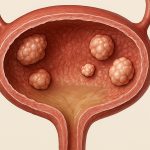Chronic cystitis, often referred to as chronic pelvic pain syndrome (CPPS) when symptoms extend beyond simple bladder inflammation, is a frustrating condition for many individuals. It’s characterized by persistent urinary frequency, urgency, and discomfort—even in the absence of an active bacterial infection. While acute cystitis typically responds well to antibiotic treatment, chronic cystitis often proves resistant, leading patients on long journeys seeking diagnosis and relief. A core concern for those living with this condition is whether ongoing inflammation can cause structural changes within the bladder itself, specifically thickening or scarring of the bladder wall. This article will delve into that question, exploring the potential for these alterations, how they are investigated, and what it means for long-term management.
The relationship between chronic cystitis and bladder wall changes isn’t straightforward. Unlike conditions causing acute trauma or severe infections, chronic cystitis rarely leads to dramatic, obvious scarring in the way one might envision a visible wound. However, subtle structural alterations can occur due to prolonged inflammation and repeated cycles of irritation. These changes may not be immediately apparent on standard imaging but can contribute to the persistent symptoms experienced by individuals with chronic cystitis. Understanding these potential modifications is crucial for both accurate diagnosis and the development of effective treatment strategies. It’s also important to note that symptom severity doesn’t always correlate directly with structural change, meaning someone with mild symptoms can sometimes have evidence of bladder wall thickening while another person with severe pain may not.
Bladder Wall Thickening & Scarring: Mechanisms and Investigation
The primary mechanism through which chronic cystitis could lead to bladder wall changes involves inflammation-induced remodeling of the bladder tissue. Persistent inflammation causes a cascade of cellular events, including the release of inflammatory mediators and growth factors. These substances can stimulate fibroblasts—cells responsible for producing collagen and other extracellular matrix components—leading to increased deposition of these materials within the bladder wall. Over time, this can result in thickening of the detrusor muscle (the main muscle layer of the bladder) and potentially alterations to the urothelium (the inner lining). It’s a slow process, often developing over years or even decades of chronic inflammation. The body attempts to repair itself constantly but when there’s continual irritation, it can lead to changes in structure rather than full healing.
Investigating potential bladder wall thickening or scarring typically involves several imaging techniques. Cystoscopy, where a small camera is inserted into the bladder through the urethra, allows for direct visualization of the bladder lining and can sometimes reveal subtle changes in texture or vascularity that suggest inflammation or fibrosis. However, cystoscopy’s ability to assess deeper layers of the bladder wall is limited. More detailed information is often obtained from ultrasound—either transabdominal (through the abdomen) or transvaginal/transrectal (for women/men respectively)—which can measure bladder wall thickness. Magnetic Resonance Imaging (MRI) provides even greater detail, allowing for assessment of both the detrusor muscle and the urothelium, and is considered the gold standard for evaluating structural changes within the bladder. Importantly, interpreting these images requires expertise, as subtle thickening can be difficult to distinguish from normal anatomical variations or artifacts.
Furthermore, biopsies – taking a small tissue sample during cystoscopy – may be performed in some cases. Histological examination of the biopsy allows pathologists to assess the presence of fibrosis (scarring), inflammation, and other cellular changes within the bladder wall. This is particularly useful for differentiating between inflammatory changes and more concerning conditions like interstitial cystitis or even bladder cancer. It’s important to remember that imaging and biopsies aren’t always conclusive; a comprehensive assessment, incorporating clinical symptoms, medical history, and examination findings, is essential for an accurate diagnosis. Understanding whether can cystitis lead to chronic pelvic inflammation is relevant to your situation can aid in diagnosis.
The Impact of Bladder Wall Changes on Symptoms & Management
Bladder wall thickening or scarring can contribute to the persistent symptoms experienced by individuals with chronic cystitis in several ways. A thickened bladder wall may be less compliant – meaning it has reduced ability to stretch and expand – leading to increased urgency and frequency, even with relatively small volumes of urine. This decreased compliance also increases pressure within the bladder, potentially exacerbating pain and discomfort. Scarring can disrupt the normal function of the detrusor muscle, impairing its ability to contract efficiently during urination. This may result in incomplete emptying of the bladder, further contributing to symptoms.
Managing patients with evidence of bladder wall changes requires a multifaceted approach. Treatment isn’t typically aimed at reversing existing thickening or scarring (as these changes are often irreversible), but rather at managing symptoms and preventing further progression. This includes lifestyle modifications such as dietary adjustments (avoiding potential irritants like caffeine, alcohol, and acidic foods), fluid management strategies, and pelvic floor muscle exercises to improve bladder control and reduce pain. Medications may be used to address specific symptoms, such as antispasmodics to reduce urgency or analgesics to manage pain. In some cases, intravesical therapies (treatments delivered directly into the bladder) like heparin instillations may be considered to potentially modulate inflammation and improve bladder compliance. Long-term follow-up is crucial to monitor symptom control and assess for any changes in bladder function. Considering how birth can lead to bladder weakness in women is important if relevant to your history.
Understanding Cystoscopic Findings & Biopsy Results
Cystoscopy can reveal visual clues about bladder health beyond just wall thickness. The appearance of the urothelium – the inner lining of the bladder – is often assessed during cystoscopy. In chronic cystitis, the urothelium may appear inflamed, reddened, or even show small areas of bleeding (glomerulations). While these findings aren’t necessarily indicative of scarring, they do suggest ongoing inflammation and irritation. Biopsy results offer a more definitive assessment of bladder wall changes. Histological examination can identify the presence of fibrosis – characterized by excessive collagen deposition – indicating scarring. The degree of inflammation present in the biopsy sample also provides valuable information about the activity of the disease process.
Importantly, biopsy findings must be interpreted within the context of the patient’s clinical symptoms and imaging results. A mild amount of fibrosis may not necessarily explain significant symptom burden, while a more pronounced level of scarring could contribute to substantial disability. Furthermore, biopsies can help rule out other conditions that might mimic chronic cystitis, such as bladder cancer or interstitial cystitis. It’s crucial to discuss biopsy results thoroughly with your healthcare provider to understand what they mean for your individual situation and treatment plan.
The Role of MRI in Assessing Bladder Wall Changes
MRI is considered the most sensitive imaging modality for evaluating structural changes within the bladder wall because it provides detailed cross-sectional images without ionizing radiation. It can accurately measure bladder wall thickness, assess the integrity of the detrusor muscle, and identify areas of fibrosis or inflammation. Advanced MRI techniques, such as diffusion-weighted imaging (DWI), can even detect subtle changes in tissue microstructure that may not be visible on conventional imaging.
MRI is particularly useful for differentiating between inflammatory changes and structural damage. For example, a thickened bladder wall due to acute inflammation might appear different on MRI than one resulting from chronic scarring. It can also help identify areas of focal fibrosis – localized regions of scarring – which may contribute to specific symptom patterns. While MRI provides valuable information, it’s important to recognize its limitations. Artifacts can sometimes occur, and interpretation requires expertise. A radiologist with experience in pelvic imaging is essential for accurate assessment. MRI isn’t typically used as a first-line investigation due to its cost and accessibility; however, it may be considered if other imaging modalities are inconclusive or if there’s concern about more significant structural damage.
Differentiating Chronic Cystitis from Interstitial Cystitis/Bladder Pain Syndrome
While chronic cystitis and interstitial cystitis/bladder pain syndrome (IC/BPS) often overlap in symptoms, they aren’t necessarily the same condition. IC/BPS is a more complex and poorly understood disorder characterized by chronic pelvic pain, urinary urgency and frequency, but without evidence of bacterial infection or other identifiable causes. It’s thought to involve dysfunction of the bladder lining and nerve pathways, leading to heightened sensitivity and pain perception.
Differentiating between these conditions can be challenging. Cystoscopy may reveal subtle differences in the appearance of the bladder lining – IC/BPS often shows characteristic glomerulations (small hemorrhagic spots) that are less common in chronic cystitis. Biopsies may show evidence of mast cell activation, a hallmark feature of IC/BPS. However, these findings aren’t always present, and there’s significant overlap between the two conditions. MRI can play a role in differentiating them by assessing the extent of bladder wall thickening. Ultimately, diagnosis is often based on a combination of clinical symptoms, examination findings, imaging results, and exclusion of other possible causes. It is important to consider whether can trauma (physical or emotional) lead to chronic pelvic pain could be a contributing factor.





















